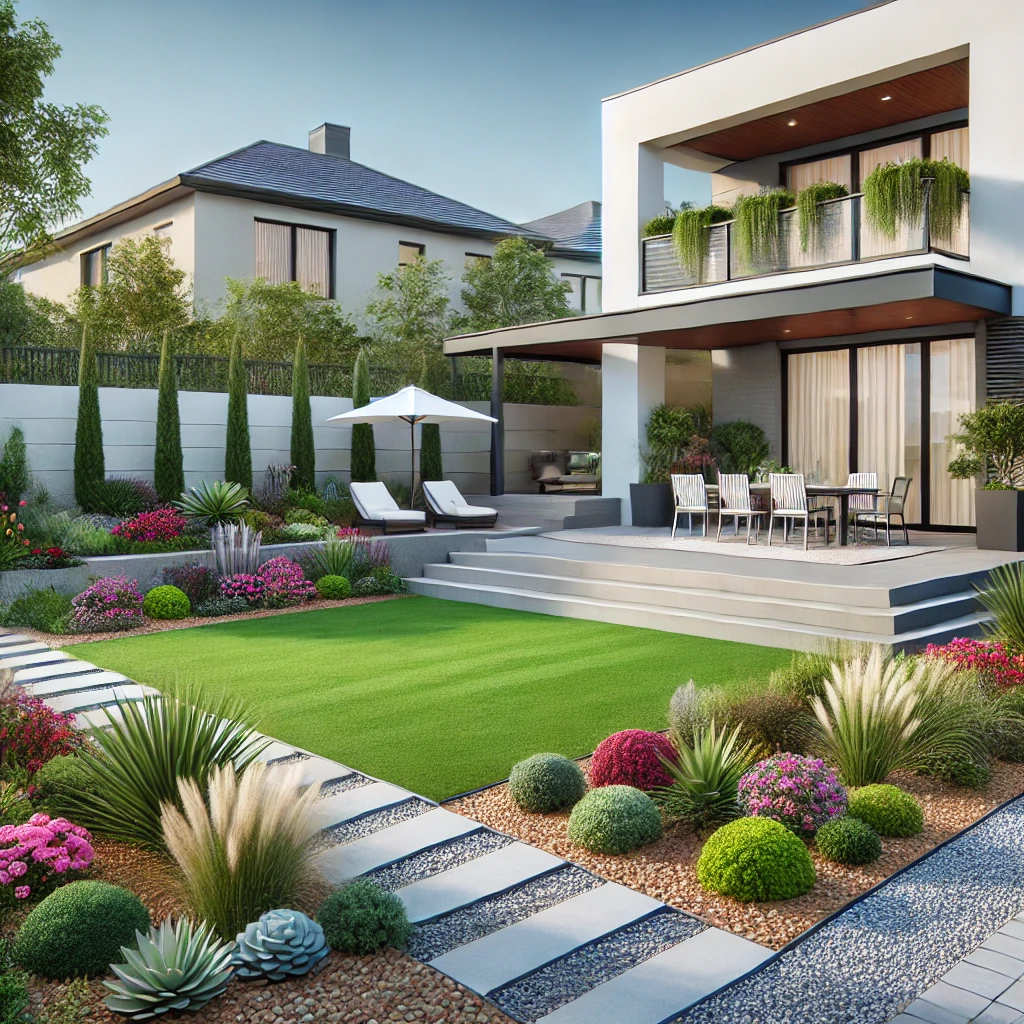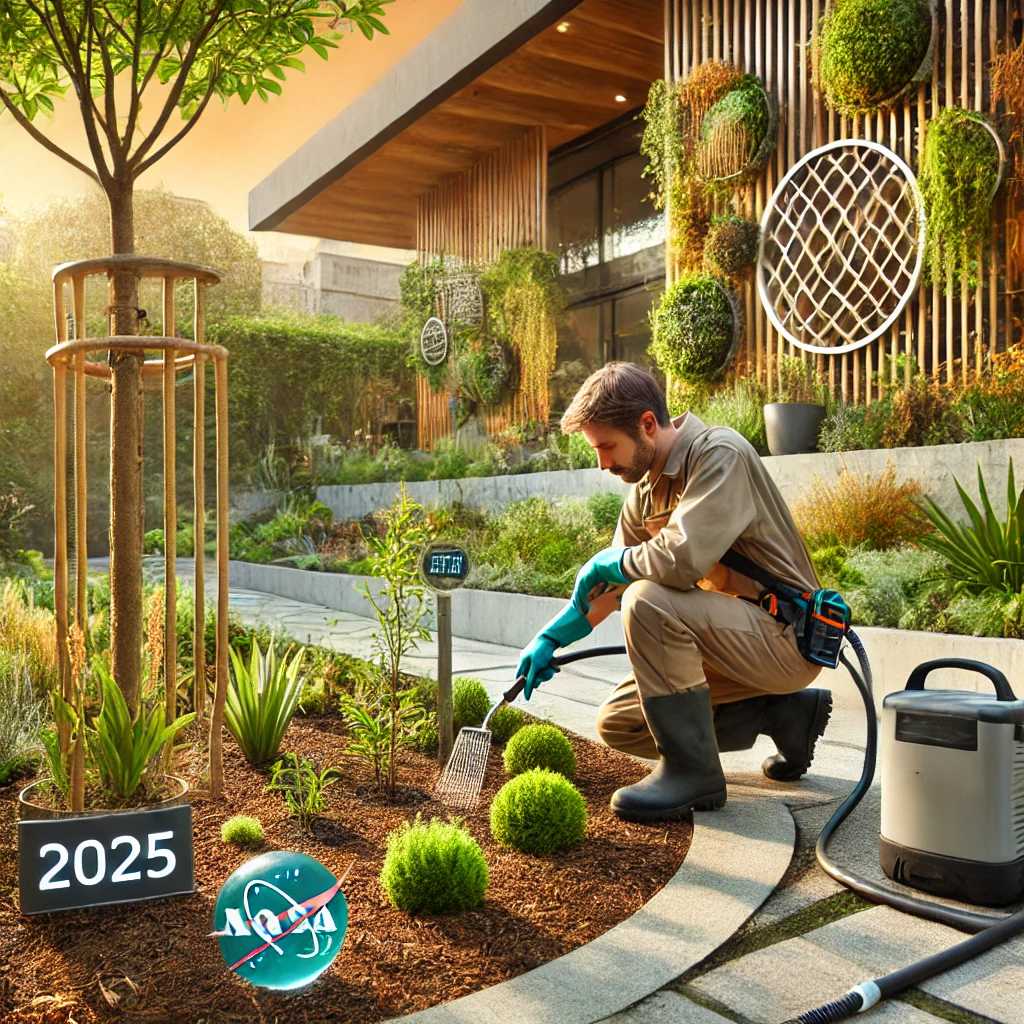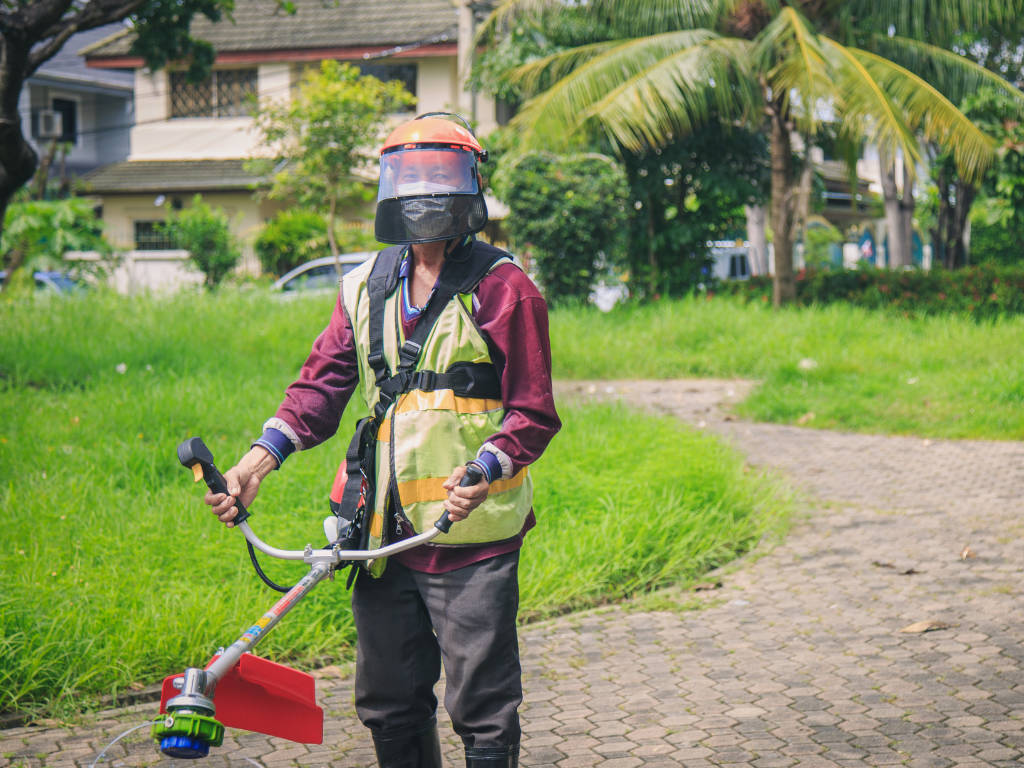As homeowners and businesses become busier, the demand for low-maintenance landscaping solutions is rising. Clients…
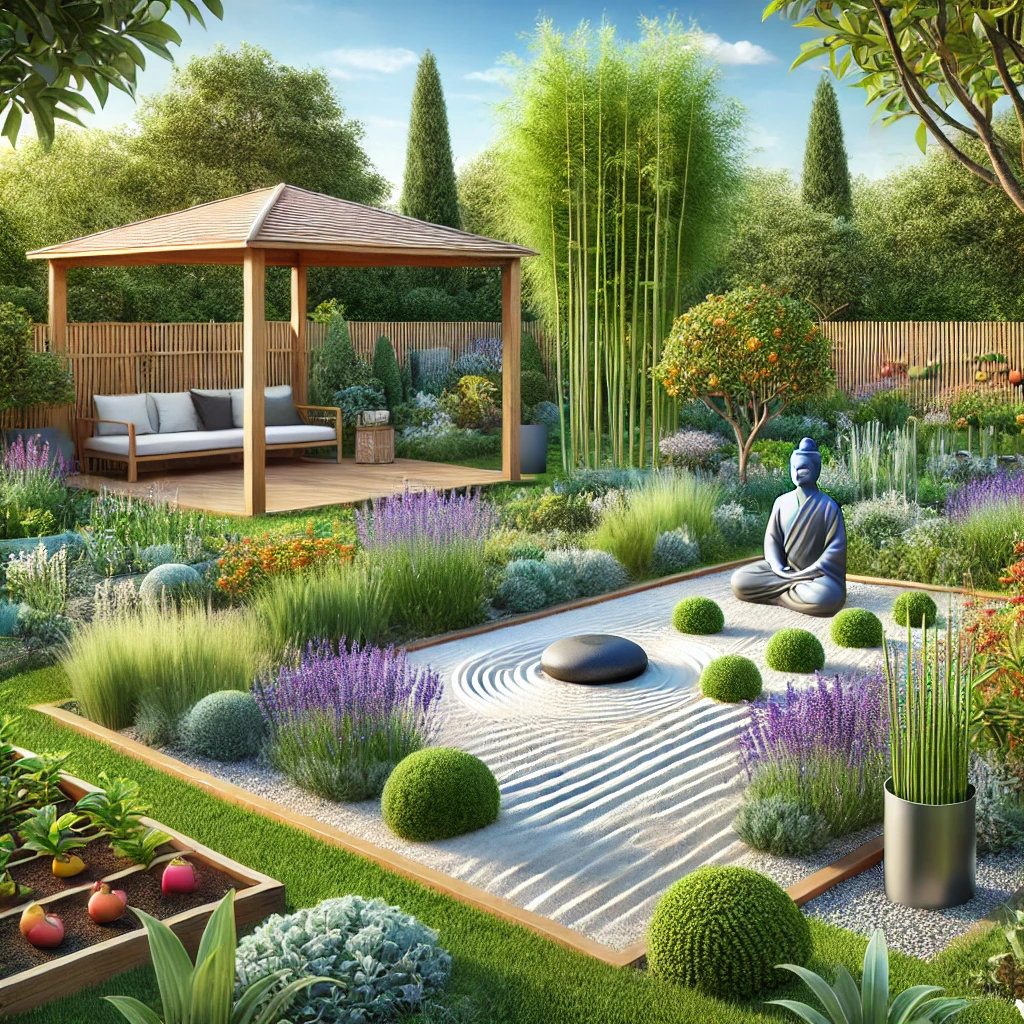
Landscape Design: Wellness-Focused Trends Shaping the Future
As the wellness movement grows, landscape design is increasingly centered on creating outdoor environments that enhance mental and physical well-being. Homeowners and businesses seek outdoor environments that promote relaxation, mindfulness, and healthy living. From therapeutic gardens designed for meditation to edible landscapes that provide fresh, organic produce, these wellness-focused trends are transforming how people interact with outdoor spaces. In this blog, we’ll explore critical trends in wellness-focused landscape design and how contractors can create serene, health-promoting environments for their clients.
🎧 Listen to the Episode
🌟 Dive into our latest podcast episode where we uncover:
- ✨ Title: Designing Wellness: The Future of Landscape Architecture
- ✨ Topics: How thoughtful design can promote well-being and sustainability.
- ✨ Why Listen: Gain insights into trends shaping the future of landscape architecture!
🎙️ Tune in below or on your favorite podcast platform! 🎙️
🎙️ Powered by iHeart Podcasts 📻
Therapeutic Gardens in Landscape Design: Spaces for Relaxation and Mindfulness
One of the most prominent trends in wellness-focused landscape design is the rise of therapeutic gardens. These gardens promote mental health, relaxation, and mindfulness and are a key component of landscape design. They offer peaceful, restorative environments where people can unwind and reconnect with nature.
Key Features of Therapeutic Gardens:
- Water Features: Calming elements like fountains or small ponds create soothing sounds that enhance relaxation.
- Sensory Plantings: Plants that engage the senses—such as fragrant flowers, soft grasses, or textured leaves—create a more immersive experience.
- Quiet Seating Areas: Secluded spots with benches or hammocks allow for private meditation and relaxation.

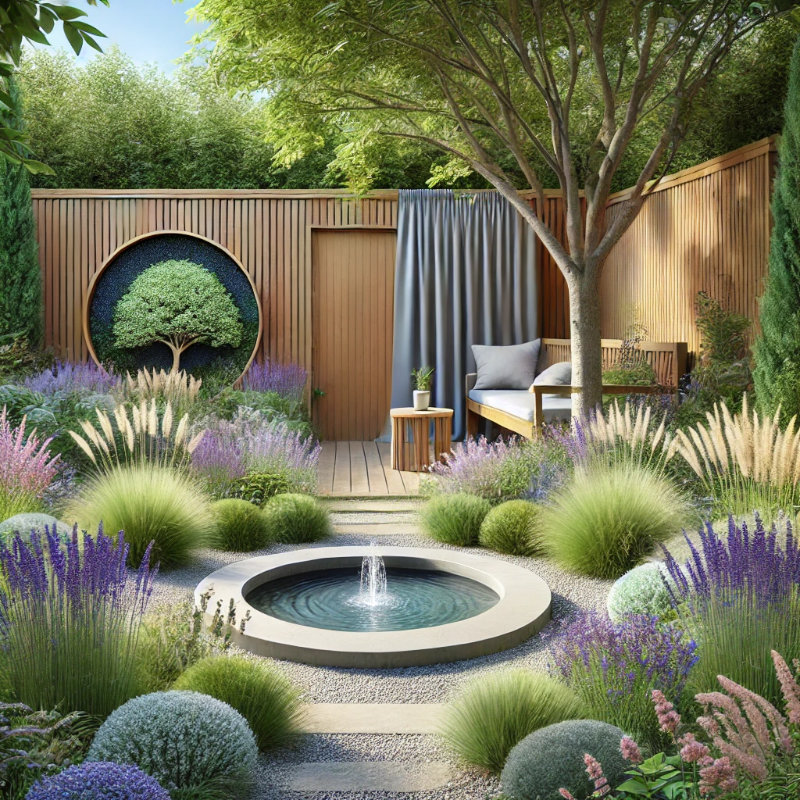
Why It’s Essential for Contractors:
Therapeutic garden designs allow contractors to meet the growing demand for wellness-focused outdoor spaces. These gardens appeal to clients seeking stress relief and a deeper connection to nature.
Edible Landscaping: A Practical Approach to Modern Landscape Design
Edible landscaping is gaining popularity as clients seek to integrate functional, food-producing elements into their gardens. These landscapes enhance aesthetic appeal and provide fresh fruits, vegetables, and herbs, promoting healthy eating and self-sufficiency.
Vital Elements of Edible Landscaping:
- Fruit Trees: Trees like apples, lemons, or figs provide food while offering shade and structure to the landscape. Urban orchards featuring community-managed fruit trees are becoming increasingly popular in cities.
- Vegetable Gardens: Raised beds or integrated plots allow clients to grow produce, reducing reliance on store-bought goods. Crops like kale, cherry tomatoes, and zucchini are easy to grow and highly nutritious.
- Herb Gardens: Aromatic herbs such as rosemary, thyme, and basil add decorative and practical value. Herbs like lavender are functional and add a soothing fragrance to any garden.
Why It’s Essential for Contractors:
Specializing in edible landscapes allows contractors to tap into the growing sustainable, healthy living trend. Clients appreciate designs that combine beauty with practicality by producing fresh food.
Grow Your Business with SendWork
Try it for Free Today!
Outdoor Living Spaces in Landscape Design: Extending the Home into Nature
With the rise in remote work and a growing focus on outdoor wellness, outdoor living spaces have become integral to modern landscape design. Homeowners are investing in spaces that extend their indoor environments into the garden, creating relaxation, entertainment, and dining areas.
Popular Features of Outdoor Living Spaces:
- Patios and Decks: These foundational elements provide versatile areas for dining, lounging, or hosting gatherings.
- Outdoor Kitchens: Complete with grills, sinks, and prep spaces, they make outdoor cooking convenient and enjoyable.
- Fire Pits and Fireplaces: Fire features create a cozy focal point for evening relaxation, extending the usability of outdoor spaces year-round.
Why It’s Essential for Contractors:
By offering outdoor living space designs, contractors can cater to clients who want to maximize their outdoor areas. These spaces appeal to those who enjoy entertaining, dining, or outdoors.
Water Features in Landscape Design: Serenity and Relaxation
Incorporating water features into wellness-focused landscapes enhances a garden’s sense of peace and calm. Water features are a vital component of wellness-focused landscape design, as their sound and visual appeal create a serene environment that promotes relaxation and stress relief.
Types of Water Features:
- Fountains in Landscape Design: Adding Soothing Soundscapes
- Ponds in Landscape Design: Reflective Spaces that Attract Wildlife
- Streams and Waterfalls in Landscape Design: Enhancing Serenity and Movement
Why It’s Essential for Contractors:
Water features are critical to wellness landscapes, offering aesthetic and emotional benefits. These elements create immersive, multi-sensory spaces that promote mental well-being.
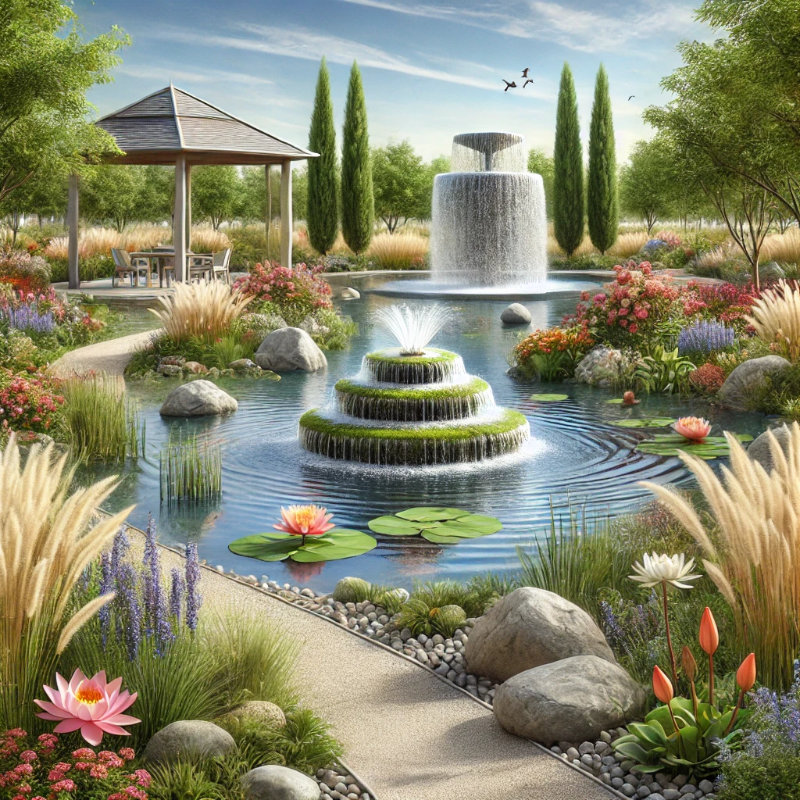
Mindfulness Gardens in Landscape Design: Spaces for Meditation and Mental Health
Mindfulness gardens are designed to encourage meditation and provide a peaceful escape from the stresses of daily life. These gardens are popular among clients seeking spaces that foster mindfulness, relaxation, and mental clarity.
Critical Elements of Mindfulness Gardens:
- Minimalist Design: Uncluttered layouts prioritize open spaces and natural elements, creating a calming atmosphere.
- Natural Materials: Organic materials like stone, wood, and gravel foster a sense of harmony with nature.
- Zen-Inspired Features: Rock gardens, raked sand, and bamboo add a tranquil, meditative quality.
Why It’s Essential for Contractors:
Mindfulness gardens appeal to clients who prioritize mental health and meditation. Contractors can attract clients by offering designs emphasizing simplicity and serenity, creating personal sanctuaries for reflection and relaxation.
Shade and Privacy in Landscape Design: Essential for Wellness
Creating shaded, private areas within wellness-focused landscapes is essential for relaxation and comfort. Elements that offer shelter from the sun and protect privacy can make outdoor spaces more inviting and peaceful.
Key Shade Solutions:
- Pergolas and Gazebos: Provide shade and a focal point for outdoor living areas, ideal for lounging or dining.
- Shade Trees: Strategically placed trees offer natural cooling benefits and enhance landscape aesthetics.
- Privacy Screens: Hedges, fences, or trellises with climbing plants create secluded areas for tranquility.
Why It’s Essential for Contractors:
Shade and privacy solutions enhance outdoor spaces by making them more comfortable and serene. These features appeal to clients seeking relaxation and wellness activities in their gardens.
How Contractors Can Capitalize on Wellness-Focused Landscaping Trends
- Expand Service Offerings: Include wellness-focused gardens like therapeutic and edible landscapes to tap into this high-demand market.
- Educate Clients: Highlight the health benefits of well-designed outdoor spaces to position yourself as an expert.
- Create Multi-Functional Spaces: Combine relaxation areas with edible gardens or outdoor living spaces to maximize appeal.
In Summary:
Landscape design focused on wellness is more than a trend—it’s a movement toward creating outdoor spaces that promote health, relaxation, and well-being. By incorporating therapeutic gardens, edible landscapes, outdoor living spaces, and mindfulness gardens into their landscape design projects, contractors can meet the growing demand for wellness-driven designs. These spaces enhance property aesthetics while providing clients with areas to relax, meditate, and connect with nature, improving their quality of life.
As landscape architect Thomas Church once said, “Gardens are a form of autobiography.” By embracing these landscape design trends, contractors can help clients tell their unique stories and position themselves as leaders in the wellness landscaping movement. Start integrating these ideas today to transform outdoor spaces into havens of health and tranquility.
Further Reading and Resources on Landscape Design
If you’re interested in diving deeper into the concepts of wellness-focused landscape design, here are some highly recommended books and resources:
- Therapeutic Landscapes: An Evidence-Based Approach to Designing Healing Gardens and Restorative Outdoor Spaces by Clare Cooper Marcus and Naomi A. Sachs
This book explores how outdoor spaces can promote mental and physical well-being through thoughtful design, with case studies and actionable insights. - Planting in a Post-Wild World: Designing Plant Communities for Resilient Landscapes by Thomas Rainer and Claudia West
A practical guide on integrating sustainability and beauty in landscape design, focusing on native plants and natural ecosystems. - The Well-Gardened Mind: The Restorative Power of Nature by Sue Stuart-Smith
A compelling exploration of how gardens and outdoor spaces support mental health and resilience.

